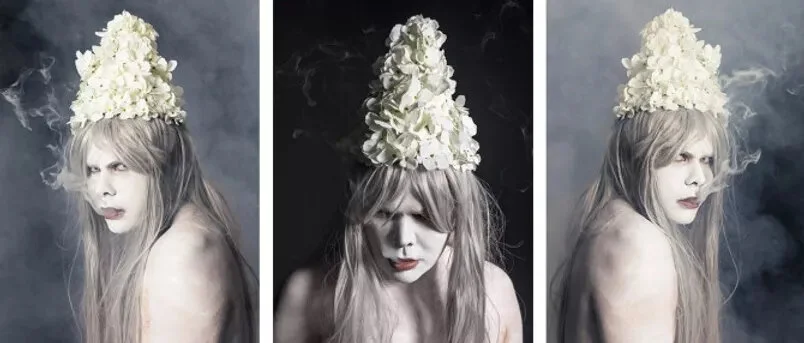REVIEW: Christian Thompson – Polari
Christian Thompson’s photographs arise from the underlying performative nature of the artist’s practice. Primarily concerned with identity, particularly in terms of the artist’s sexuality and Indigeneity, his works see Thompson adopt and play with various personas by painting his skin and adorning himself with natural accessories such as flowers and feathers.
This exhibition’s title, Polari, refers to a centuries-old slang dialect originating in Britain but in use throughout the English-speaking world by various subcultures, including homosexuals as well as prostitutes, actors, criminals, and carnival folk. Thompson’s investigation into evolving identity through changing appearance can be seen to echo the use of Polari as a form of disguise for the many communities that employ it.
The works in Polari are dominated by the dichotomy of black and white, aesthetically and conceptually. Once again the artist plays dress-ups with his identity, obscuring his skin and even eye colour with monochrome extremes. The characters Thompson plays have been printed larger than life-sized, giving them an imposing presence. The figure occupying the central work in the triptych Trinity (2014) casts his gaze downwards through spirals of exhaled smoke, eyes partially obscured by a long grey wig, head adorned with a tall floral crown. In the two images flanking this one, the same character stares over his shoulders into the eyes of the viewer, simultaneously accusatory and vulnerable.
In Echo I and Echo II (both 2014), Thompson appears, again with white-painted skin, staring wistfully into the distance. In both works the artist wears a white and black feathered headpiece, nestled amongst apparently natural curls. The tones of the feathers advance and recede against respectively white and black backgrounds in each image. Thompson’s photographs are all printed on metallic paper so that the artist’s skin takes on a silvery sheen and the feathers, coils of hair and tendrils of smoke appear to emerge outwards from the surface of the works.
The exhibition also includes two photographs of crystals, rendered in the same scale as Thompson’s figures. These images form a connection to a 3D-printed cast resin sculpture resembling a giant crystal, entitled All revolutions are led by the young (2013), made by Thompson for the exhibition Pagan Sun at Gallery Gabrielle Pizzi in late 2013. They also bring to mind crystals placed over the eyes of the subject in the artist’s 2012 photograph Forgiveness of Land. This could be seen to reference the practice in some Indigenous Australian cultures of using crystals in burial rites. The titles of both crystal works, Sirens and Ariel, refer to mythological creatures who used the sexualised female form as a lure.
The deceptively minimal yet strong compositions Thompson has employed in Polari continue the artist’s investigation into the role played by embellishment and disguise in the creation of personal and sexual identity. These intriguing works invite the viewer to enter a shared space of intentional ambiguity with Thompson and his alter egos, and stay a while.
Polari, Wed to Sat 11am-5pm, until 30 May; Michael Reid, 44 Roslyn Gardens, Elizabeth Bay; (02) 8353 3500, michaelreid.com.au
